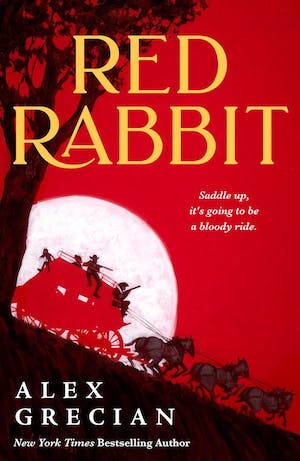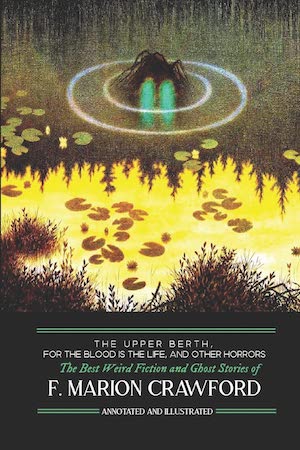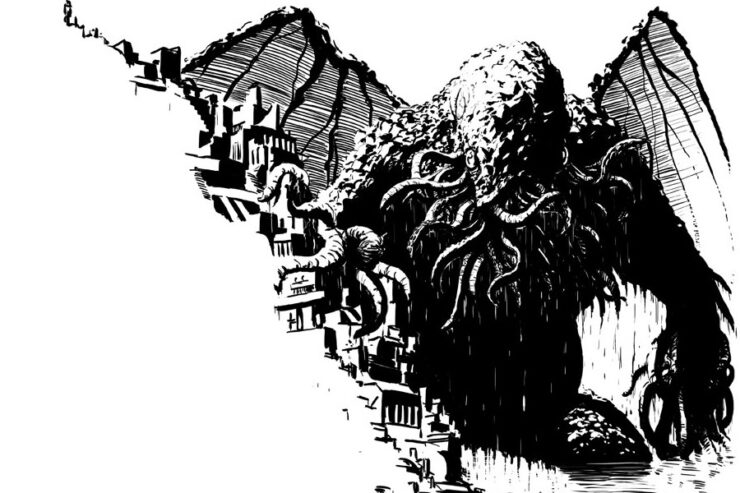Welcome back to Reading the Weird, in which we get girl cooties all over weird fiction, cosmic horror, and Lovecraftiana—from its historical roots through its most recent branches.
This week, we cover F. Marion Crawford’s “For the Blood is the Life,” first published in Collier’s in December 1905. Spoilers ahead!
“It is wonderful what a natural charm there is about murder and sudden death in a romantic country like this.”
Narrator and his artist friend Holger have dined atop a watchtower on Italy’s Calabrian coast, built in the 1500s to keep off pirates. It stands isolated on a rocky promontory; how Narrator acquired the place doesn’t matter to this story.
The moon rises, illuminating everything between the promontory and the sea. Narrator observes that Holger has noticed a certain spot, and waits for him to mention it. At last Holger asks if Narrator sees a mound beside a boulder, grave-like, with a body atop it. It must be some strange effect of the moonlight.
Narrator sees this phenomenon every moonlit night, and the mound is a grave. Its topside occupant is nothing – he’s looked up close for himself.
Holger goes down to investigate. Ten paces away, he stops short, backs up, stops again, and Narrator knows he’s reached the point where the Thing disappears. When Holger ascends the mound, Narrator sees the Thing wrap white arms around him to climb his body. He shouts for Holger to rejoin him. Holger steps from the mound reluctantly. The Thing clings to him, stretching like a misty train. As Holger shakes it off, Narrator hears a “little wail of pain,” as if from an owl. He realizes the white arms must have embraced him, too, and that the wail is the Thing’s cry.
He and Holger drink wine, looking at the mound and its Thing. Narrator might make a story about them, Holger suggests. There is a story, Narrator says…
***
Old Alario lived in the village atop the promontory. He supposedly made his fortune selling sham jewelry in South America. Exposed, he returned to the village and set about enlarging his former house. He hired masons from Paola, a one-eyed Neapolitan and a scarred Sicilian. Alario was a widower with one son, Angelo, who was to marry the daughter of the village’s richest man. Though the marriage was arranged, the young people were said to love each other.
Many loved handsome Angelo, including Cristina, a wild girl, black-eyed and red-lipped, with a devilish tongue but good nature. She did odd jobs to earn her living and especially liked working at Alario’s house. When the old man sickened, Angelo being away, Cristina was dispatched to the nearest town for a doctor. Alario died that evening. With their customary horror of death, the watchers fled, including Alario’s servant. The scoundrelly masons crept into the deserted house and stole the iron-bound box in which Alario had secreted his money. They descended the gorge that led to the beach and dug a hole in which to stash their loot – right where the mound is now.
Returning from her errand, Cristina heard digging. Fearless, she crept up and surprised the thieves. They killed her and buried her body with Alario’s box. To secure an alibi, they went to a village crony’s house, where they were found after Alario’s servant reported the theft. They eluded capture, however, and vanish from Narrator’s tale.
With his inheritance gone, Angelo lost his bride and his status; the house and a patch of land were all that remained to him. He scraped out a living farming, becoming increasingly morose in his poverty and isolation. At twilight, he wandered in lonely places, often resting near the path down the gorge. Here he wasn’t quite alone, for a woman would noiselessly ascend to a clump of chestnut trees and beckon. Her lips were red; her smile revealed two sharp teeth; the eyes in her pale face held a “furious and unappeased physical hunger.” He knew it was Cristina and that she was dead, but he wasn’t afraid, for surely he was dreaming.
Buy the Book


Red Rabbit
Eventually the dream extended to him joining the woman and going down the gorge, while her breath and kisses and grip burned or froze him. He couldn’t tell which, or if he was awake or asleep, or whether Cristina was alive or dead. All he knew was that she was the only creature who loved him. At dawn he’d wake on the mound, weak and sick, resolving to avoid the gorge path and go to his bed “like a Christian man.” Yet every evening he’d relive the dream of terror and delight. Watching Angelo’s decline, the villagers said he was “consuming himself” over his lost bride, and they would laugh, this “not being a very romantic country.”
One day Antonio, the man who kept Narrator’s watchtower, returned from travel. Glancing toward the mound after midnight, he saw something that sent him straight to the village priest. “I have seen how the dead drink the blood of the living,” he confessed. “And the blood is the life.”
The priest armed himself with book and holy water, Antonio with pick and shovel and a hidden stake, and they surprised the strange couple on the mound. Cristina vanished. Antonio and the priest led the half-dead Angelo away, then dug. Alone, Antonio went down into the abode of what was neither alive nor dead. What he did there, he’d never speak of afterwards, but the priest heard a struggle, then a woman’s shriek, then the thud of the iron-bound chest Antonio tossed out. He emerged white-faced and covered with blood not his own, and he furiously refilled the hole.
***
Narrator finishes his story. Antonio hasn’t been the same man since that night. Nor has Angelo returned to former heartiness in spite of regaining his inheritance. The mound remains, and the Thing that lies on it in the moonlight. Is it quite dead yet, Holger wonders. Narrator wonders the same, but he has no desire to delve into the mound, even in broad daylight.
What’s Cyclopean: The narrator raises many questions by describing his housesitter as a “gnome-like little being who was once a miner and who attached himself to me a long time ago,” none of which are answered in this story.
The Degenerate Dutch: Cristina is compared to a Romany, though not using that word. Because she’s wild, and has red lips and black eyes and “the tongue of a devil,” and likes to travel.
Libronomicon: The old priest has “read in old books of these strange beings which are neither quick nor dead.”
Ruthanna’s Commentary
Judging from his stories, Crawford must have been an interesting dinner companion. Sit down for a drink, and you might hear about mid-ocean hauntings, or get startled from your chair by a screaming skull. Or, in this case, learn the explanation for an unusual visual illusion. Yessirree, that’s what it is. Just a trick of the light. And a bit of harmless local gossip.
Your party won’t be dull, anyway. In some cases that’s rather the point. Crawford provides comfortable shivers, suitable for the pages of your evening magazine. Nevertheless, some shivers are closer than others: close enough to see and feel, perhaps even a bit… draining. Maybe Holger should have brought along a sharp-toothed skull for protection? But clinging phantoms or no, he’s at little risk: Cristina seems to be a very personal sort of vampire.
Turn-of-the-twentieth-century vampires require a certain ambiance. Your 1990s vampires and later get by on leather jackets and seedy nightclubs; their predecessors required crumbling castles in exotic locales. Well, exotic to Americans, anyway. Styria, Transylvania, Calabria: all may be real places with real local concerns, but for the horror writer they provide excitingly craggy mountains inhabited by conveniently superstitious peasants, backed by enticingly-vague yet potentially-ominous history. Welcome to Ruritania?
I normally enjoy settling in by the fire for a Crawford yarn. In this case I found the matte-painted background slapdash enough to distract. I strongly suspect that Italian peasants even a hundred years ago did not commonly flee deathbeds in a superstitious panic. I’m curious whether Angelo’s father’s old servant really comes by his house occasionally to wash one shirt, just to rub salt in the wound of his poverty. I want to know more about the narrator’s housesitter than I do about Cristina. And never mind why the narrator lives in a picturesque castle, with the most convenient place to eat conveniently overlooking the sight of a… hidden?… vale where thieves might stow illicit goods and inconvenient witnesses. If I had bodies to hide, I would certainly hide them directly in the sightlines of the local nobility, within easy walking distance. It makes me think of the jagermonsters from Girl Genius: “Dis iz turning into wun of dose plans. Hyu know – de kind vere ve keel everybody dot notices dot ve’s keelin’ people?” Any plan where you lose your hat and create a vampire is a bad plan.
Also, what turns Cristina vampiric? Carmilla and Dracula both convert by feeding, but Cristina gets knocked over the head by ordinary mortal murderers. Is it just the strength of her obsessive love for Angelo, more pure (and more sexual and stalker-ish) than that of the other girls who fawn over his wealth, that recalls her to un-life? Had he, perhaps, already dallied with her? Dead lovers can be the most dangerous kind, per any number of ballads. But no, he doesn’t “care a straw” for her. At least not until she develops the posthumous power to enthrall.
Not every vampiric tale needs to answer these questions. But if I find myself asking them, it suggests an insufficiency in the mood-setting.
I do feel bad for Cristina, who has a dull lifestyle relative to her more famous predecessors. Dracula has his own castle and entourage, and riches enough to invest in real estate. Carmilla convinces her victims’ families to host her for months at a time, doting on her while she plays the adorable innocent. Cristina is tied to her grave, unable to even take advantage of the riches buried there, let alone continue the wandering ways that so pleased her in life. For all of her Scary Sex vibes, she’s stuck with the trappings of older and less enticing legends. Her unlife definitely places the emphasis on un. She provides an endless topic of dinner table conversation – but she just doesn’t get to join in any of the fun.
Anne’s Commentary
Calabria, the toe of Italy’s boot, looks like it intends to kick Sicily a good one and send it careening into Sardinia. But Sicily being no pushover, Calabria might stub itself mightily – maybe this is why, despite its picturesque coastline and mountains, it’s not overrun by tourists and remains relatively inexpensive to live in. A mighty stubbing would doubtless trigger earthquakes, flooding, avalanches, maybe even vampires coughed out of their unmarked graves.
Not that vampires are a bad thing. I have watched enough episodes of House Hunters International and Ghost Hunters International to know that for buyers of a certain mindset the combination of quaint affordable houses and undead neighbors could be irresistible. I’m not currently in the market for a second home, but if I were, I’d check out Crawford’s Calabrian watchtower.
Imagine the real estate ad:
Unique opportunity, as beachfront as they come, combining unmatched privacy and nearby village amenities on the sunny Calabrian coast! BnB and rental possibilities out the butt! Historically significant Renaissance-era structure, formerly a watchtower defending against pirates, imagine the romance and the envy of your friends! A restorer’s delight, or renovate the interior to modern standards, but move-in ready for the adventurous buyer. Rooftop deck with kitchen and unparalleled views of sea, cliffs, and mysterious mound reputed to be haunted but harmless, with vampiric presence already staked for your convenience, no exorcism required. Act now! Can’t last!
Or maybe it can last, the vampiric presence, that is. Crawford’s narrator and friend Holger are more than justified in wondering whether Cristina is “quite dead yet.” As apparitions go, she’s as reliable as Yellowstone’s Old Faithful – just check your moon-phase calendar for best viewing dates, and weather permitting, there she is for your viewing pleasure and/or shudders.
Pleasure and/or shudders, or as Crawford puts it, “terror and delight,” form the basis for the vampire’s undying appeal to readers and viewers. On one end of the terror-delight spectrum are the pure-horror bloodsuckers, more bestial than human, the icky-looking ones their mamas wouldn’t want to kiss. On the other end are the hemomaniacs too sexy for victims to resist. In the middle you might put the Buffyverse vampires, who can look drop-dead gorgeous or jump-scare demonic, depending on their mood or hormones or the needs of the script. Vampires also arouse sympathy along a spectrum, ranging from the irremediably evil or alien to the totally relatable, tragic, even admirable.
In life, Cristina is a vivacious, engaging, attractive character with enough spice (that devil of a tongue) and toughness to get us on her side. Who would you want to hang out with, Angelo’s prim and not-so-loving-after-all fiancée or Cristina? Nor is she to blame for her unfortunate end. Crawford even takes care to indicate that her fearlessness in investigating the thieves’ digging isn’t sheer recklessness – fishermen often rummaged about the beach at night in search of anchor-worthy rocks or firewood. Why Cristina became a vampire is unclear. No vampire has preyed on her. She’s not a witch or other malefactor; in fact, she’s the victim, not the victimizer, the murdered, not the murderer. Was some demonic spirit hanging around the beach when her corpse became available for possession? Was it enough that the thieves buried her in unconsecrated ground? Did it suffice that she was wild and just a bit un-Christian?
I like to think Cristina was too tenacious of life to die in such a lame manner. Romantic corollary: Jilted Angelo’s nightly presence near her grave quickened her loving spirit to undeath, so she could comfort him, that’s all, but undeath is an awfully hungry state of existence. If a fellow wants some vampiric affection, he at least has to “buy” the lady dinner.
What is clear is Cristina’s place among the classic vampire seductresses, for all that her exploits are of short duration. Like her sisters in erotic exsanguination, she looks her sexiest with pendant drops of blood on her fangs or an artistic crimson trickle down her chin – no gross clots of gore for Cristina or shredded flesh for her lover. Leave such excess for the horror-vamps and werewolves. Still, like even the queen-seductress Carmilla, she’ll leave her chosen one dead at last. Or dead, then undead.
That’s fine if you turn undead and fabulous, like a Lestat. I don’t think simple and rather bland Angelo would have made an interesting vamp. Plus he might have wanted to turn his former fiancée, and she could have proven to be the most cold-hearted, snubbing Bitch-Empress of the Night of them all.
Not, on second thought, that such an outcome need be a bad thing. Besides, we have enough wraith-thin vampires. A nice plump one would introduce some size equity into this monsterdom.
Next week, we may finally give up on solo world-saving in Chapters 5-6 of Max Gladstone’s Last Exit.
Ruthanna Emrys is the author of A Half-Built Garden and the Innsmouth Legacy series, including Winter Tide and Deep Roots. You can find some of her fiction, weird and otherwise, on Tor.com, most recently “The Word of Flesh and Soul.” Ruthanna is online on Twitter and Patreon and on Mastodon as [email protected], and offline in a mysterious manor house with her large, chaotic household—mostly mammalian—outside Washington DC.
Anne M. Pillsworth’s short story “The Madonna of the Abattoir” appears on Tor.com. Her young adult Mythos novel, Summoned, is available from Tor Teen along with sequel Fathomless. She lives in Edgewood, a Victorian trolley car suburb of Providence, Rhode Island, uncomfortably near Joseph Curwen’s underground laboratory.














